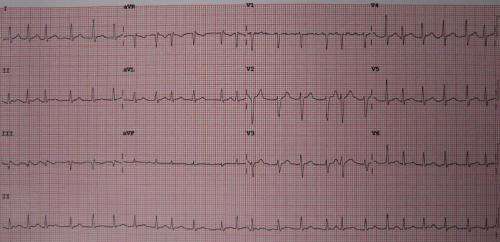A 12 lead ECG showing atrial fibrillation at approximately 150 beats per minute. Credit: James Heilman, MD/Wikipedia/CC BY-SA 3.0
Science has long shown that men are at greater risk for developing atrial fibrillation (AFib) than women; but it has never been fully understood why women would be protected from developing the condition. New research from the Smidt Heart Institute at Cedars-Sinai challenges this conventional wisdom by demonstrating that women—when height is accounted for—have a 50% higher risk of developing the abnormal heart rhythm disturbance when compared to men.
The novel findings, published today in the peer-reviewed journal JAMA Cardiology, suggest medical practitioners must remain vigilant in promoting AFib prevention—and early interventions—among both female and male patients.
"This is the first study to show an actual flip in the risk of atrial fibrillation," said Christine Albert, MD, MPH, chair of the Department of Cardiology in the Smidt Heart Institute and senior author of the JAMA Cardiology study. Albert also led the national VITAL Rhythm Trial upon which these findings are based. "In this population of 25,000 individuals without prior heart disease, after adjusting for differences in height, women were at higher risk for developing AF than their male counterparts—upward of 50%."
As Albert explains, the taller an individual is, the more at risk they are for AFib. This is why women have been shown to have a lower risk of the disease, since they tend to be shorter than men.
"Our study, however, surprisingly suggests that if a man and a woman have the same height, the woman would be more likely to develop AFib," said Albert. "Now the question has changed: Instead of why are women protected, now we must seek to understand why women are at a higher risk."
Atrial fibrillation is the most common type of abnormal heart rhythm and, without treatment, can lead to stroke or heart failure. Once a woman is diagnosed with AFib, she is more likely to experience one of these adverse consequences than a man, making AFib prevention exceedingly important in women.
Patients diagnosed with the condition can be treated with blood thinners and outpatient procedures such as cardioversion or ablation, or heart surgery, but women are less likely to undergo invasive treatments for AFib such as ablation.
It's estimated that by the year 2030, more than 12.1 million Americans will have the condition. Albert notes that as the general population increases in size—both in height and weight—cardiologists can expect that more individuals will be diagnosed with atrial fibrillation.
"With incidence on the rise, it's more imperative than ever to be offering preventive strategies and early diagnostic interventions to all patients," said Albert, professor of Cardiology at Cedars-Sinai and the Lee and Harold Kapelovitz Distinguished Chair in Cardiology.
The most effective prevention strategies against AFib in men and women, Albert says, include maintaining a healthy weight, controlling blood pressure, limiting alcohol use and exercising moderately.
"These lifestyle modifications are important to those at risk for atrial fibrillation, but also important modifications all women can consider to prevent other heart-related conditions," said Noel Bairey Merz, MD, director of the Barbra Streisand Women's Heart Center in the Smidt Heart Institute and a pioneer in women's heart disease.
Bairey Merz, who was not involved with the JAMA Cardiology study, says the data underscores the importance of atrial fibrillation prevention in women.
"Atrial fibrillation is a disease we want to prevent, regardless of sex or gender," said Albert. "This informative study is an important step for the medical community to take note of, and begin discussing AFib risk with all patients, whether male or female."
More information: JAMA Cardiology (2022). https:/jamanetwork.com/journals/jamacardiology/fullarticle/10.1001/jamacardio.2022.2825
Journal information: JAMA Cardiology
Provided by Cedars-Sinai Medical Center





















